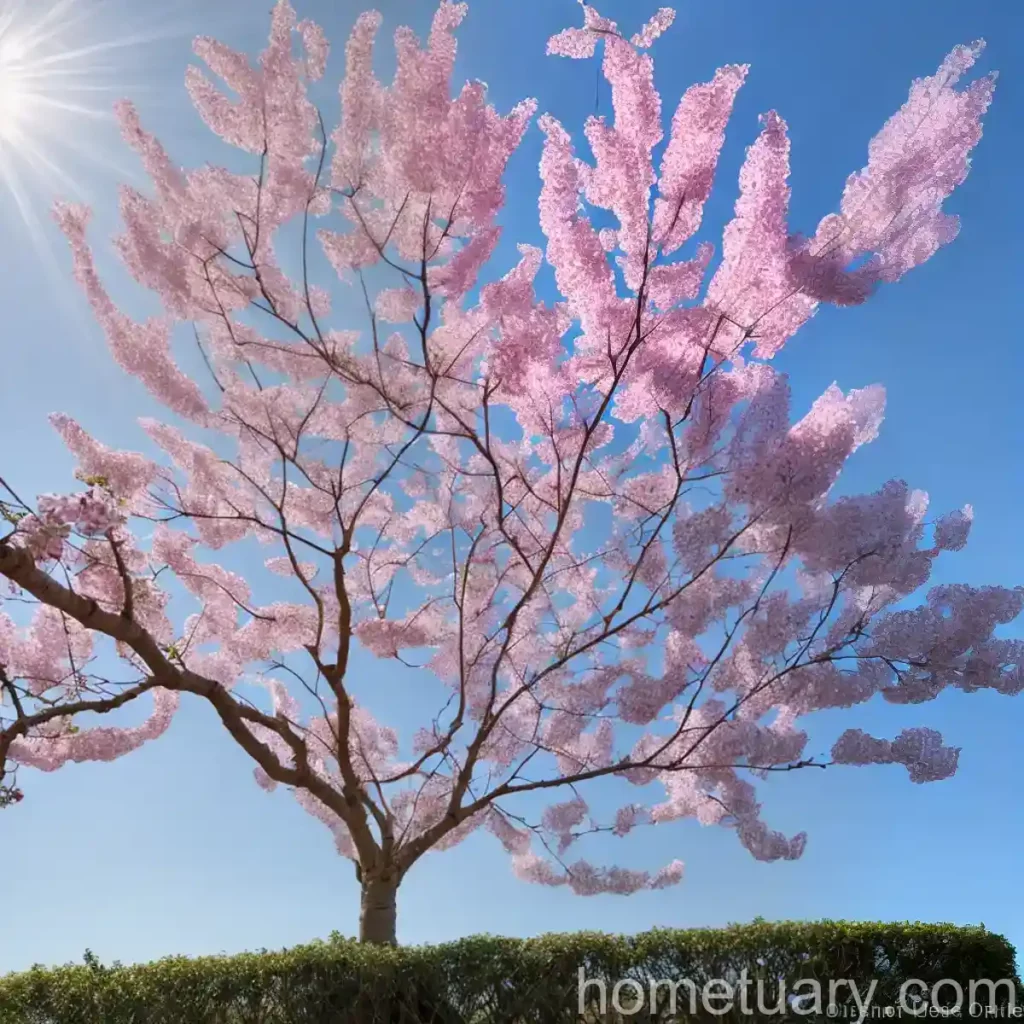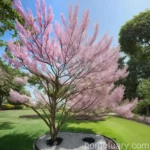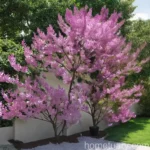Eastern Redbud (Cercis canadensis ‘JN2’ THE RISING SUN): A Gardener’s Guide
The Eastern Redbud, scientifically known as Cercis canadensis ‘JN2’ THE RISING SUN, is a stunning deciduous tree that is native to eastern North America. This unique cultivar is highly sought after for its remarkable landscape appeal, making it a popular choice among gardeners and landscape designers. In this comprehensive guide, we will explore the key characteristics, cultivation requirements, uses, and maintenance practices for this captivating tree. Whether you are a seasoned gardener or a novice plant enthusiast, this guide will provide valuable insights into harnessing the beauty and resilience of the Eastern Redbud.
What is the Eastern Redbud (Cercis canadensis ‘JN2’ THE RISING SUN)?
The Eastern Redbud is a captivating deciduous tree that belongs to the Fabaceae family. It is renowned for its vibrant display of pink to purple flowers that bloom along its branches in early spring, adding a spectacular burst of color to the landscape. The ‘JN2’ THE RISING SUN cultivar is particularly cherished for its distinctive foliage, featuring heart-shaped leaves that emerge in a mesmerizing blend of multi-colored hues, ranging from apricot orange to emerald green. As the seasons progress, the foliage undergoes captivating transformations, further enhancing the tree’s visual allure.
Key Takeaways – Eastern Redbud (Cercis canadensis ‘JN2’ THE RISING SUN)
Culture
The Eastern Redbud thrives in a variety of cultural settings, from urban landscapes to woodland gardens, due to its adaptability and aesthetic appeal. Its compact size and ornamental foliage make it a versatile choice for both large and small-scale plantings.
Uses
- Ornamental Tree: The Eastern Redbud serves as an exquisite focal point in residential landscapes, botanical gardens, and public parks, thanks to its showy flowers and striking foliage.
- Wildlife Habitat: The tree’s flowers attract pollinators, while its seeds provide a valuable food source for birds and small mammals, contributing to ecological diversity.
Water
Moderate water requirements; regular watering is essential during the establishment phase and dry spells to maintain soil moisture. Once established, the Eastern Redbud exhibits good tolerance to periodic drought conditions.
Sunlight
Partial to full sun exposure is preferred for optimal growth and flowering. However, the tree also demonstrates a degree of shade tolerance, making it suitable for various light conditions.
Fertilizer
A balanced, slow-release fertilizer applied in early spring can support the tree’s growth and flowering. Additionally, organic mulch can be beneficial for moisture retention and soil enrichment.
Soil
Well-drained, fertile soils with a slightly acidic to neutral pH are ideal for the Eastern Redbud. Soil that retains moisture without becoming waterlogged is crucial for sustained growth and health.
Pruning
Pruning is best performed during the dormant season to shape the tree, remove dead or damaged branches, and encourage a more open canopy. Prompt removal of suckers and low-lying branches can contribute to a tidier and more visually appealing growth habit.
Propagation
Propagation of the Eastern Redbud can be achieved through methods such as seed germination, stem cuttings, and grafting, offering opportunities for enthusiasts to propagate specific cultivars and preserve desirable traits.
Container Popularity
The Eastern Redbud is well-suited for container cultivation, allowing gardening enthusiasts with limited space to enjoy its beauty on patios, balconies, and other confined settings.
Common Diseases
The Eastern Redbud is susceptible to certain fungal diseases, including verticillium wilt, cankers, and leaf spots, which can impact its vigor and aesthetics if left unmanaged.
Disease Diagnosis
Timely monitoring of the tree for symptoms such as wilting, discoloration, and lesions is essential for diagnosing potential diseases and implementing appropriate control measures.
Common Pests
Insect pests such as caterpillars, scale insects, and webworms can affect the Eastern Redbud, necessitating vigilance and targeted interventions to mitigate their impact.
Botanist’s Tips
- Enhancing Pollinator Diversity: By planting Eastern Redbuds, gardeners can contribute to the conservation of pollinator species and support the pollination of neighboring plants.
- Promoting Biodiversity: The Eastern Redbud’s ecological contributions extend beyond its ornamental value, serving as a valuable component of diverse ecosystems.
Fun Facts
- The Eastern Redbud is the state tree of Oklahoma, making it a symbol of natural beauty and resilience in the region.
- Indigenous communities utilized various parts of the tree, including its bark and flowers, for medicinal and culinary purposes, underscoring its cultural significance.
Links to External Resources
USDA Plant Profile for Cercis canadensis
American Horticultural Society Plants Database
Missouri Botanical Garden Guide to Cercis canadensis
In the subsequent sections, we will delve deeper into the nuanced aspects of cultivating and caring for the Eastern Redbud, providing actionable insights for enthusiasts and horticultural professionals alike.
Cultivation and Care of the Eastern Redbud
The successful cultivation of the Eastern Redbud hinges on understanding and addressing its specific requirements, from soil and water to sunlight and nutrients. By paying careful attention to these factors, gardeners can ensure the tree’s vigor, resilience, and ornamental appeal.
Soil and Water
The Eastern Redbud thrives in well-drained soils with good fertility and a slightly acidic to neutral pH. It is essential to avoid waterlogged or compacted soils, as they can hinder root development and lead to drainage issues. Prior to planting, amending the soil with organic matter can enhance its structure and nutrient content, contributing to the tree’s establishment and long-term health.
Regular watering is crucial during the tree’s initial establishment, typically within the first year of planting. Consistent soil moisture, without excessive saturation, promotes robust root development and canopy growth. In periods of prolonged drought, supplemental irrigation may be necessary to sustain the tree’s vitality and prevent undue stress. However, it is important to prioritize well-drained conditions to circumvent waterlogging, which can predispose the tree to root diseases and physiological disorders.
Sunlight Requirements
The Eastern Redbud thrives in partial to full sun exposure, benefiting from at least six hours of direct sunlight daily. In locations with hot climates, providing some afternoon shade can mitigate heat stress and optimize the tree’s overall health. However, excessive shade can diminish flowering and foliage coloration, compromising the tree’s ornamental value. By assessing the available sunlight and selecting appropriate planting sites, gardeners can harness the tree’s full potential for visual impact and resilience.
Fertilization Practices
A balanced, slow-release fertilizer applied in early spring can supply essential nutrients to the Eastern Redbud, bolstering its growth, flowering, and overall vigor. When selecting a fertilizer, opt for formulations specifically designed for woody ornamental plants, as they contain appropriate ratios of nitrogen, phosphorus, and potassium, along with micronutrients. As the tree matures, periodic fertilization can promote sustained health and vigor, particularly in nutrient-deficient soils or high-demand environments where competition for resources is prevalent.
Pruning and Training
Pruning plays a pivotal role in shaping the Eastern Redbud’s growth habit, removing deadwood, and improving air circulation within the canopy. The dormant season, typically late winter or early spring, is an opportune time to conduct pruning activities, as the tree is dormant and lacks active growth. Major pruning efforts, such as structural modifications and canopy thinning, should be approached judiciously to avoid causing stress or compromising the tree’s natural form. Regular removal of errant growth, suckers, and damaged branches can promote a healthier and more aesthetically pleasing tree, enhancing its value in the landscape.
Propagation Techniques
For gardening enthusiasts seeking to propagate the Eastern Redbud, several methods can be employed to propagate specific cultivars, including the ‘JN2’ THE RISING SUN variety. Here are a few common propagation techniques for Cercis canadensis:
- Seed Germination: Harvesting seeds from mature pods and germinating them in a controlled environment can yield new plants with genetic variability.
- Stem Cuttings: Taking semi-hardwood cuttings from healthy, actively growing stems and rooting them under mist or controlled humidity can result in genetically identical clones of the parent plant.
- Grafting: Creating graft unions between a selected scion and a compatible rootstock can perpetuate the characteristics of desirable cultivars, ensuring uniformity and predictability in the propagated plants.
By employing these propagation techniques, horticulturists and hobbyists can not only expand their collections but also contribute to the conservation and dissemination of valuable genetic diversity within the Cercis canadensis species.
Container Cultivation
The Eastern Redbud is well-suited for container cultivation, enabling gardening enthusiasts with limited outdoor space to enjoy its ornamental attributes on patios, balconies, and terraces. When cultivating the tree in containers, consider the following guidelines to ensure its health and vitality:
- Selecting a Suitable Container: Choose a spacious container with adequate drainage holes to prevent water stagnation and root suffocation.
- Well-Draining Soil Mix: Utilize a high-quality potting mix that promotes drainage and aeration, catering to the tree’s root development and nutrient uptake.
- Regular Watering: Monitor the moisture level of the soil and water the tree as needed, ensuring that the container does not dry out excessively or become waterlogged.
- Sunlight Exposure: Position the container in a location that receives ample sunlight, allowing the tree to photosynthesize and thrive.
Container cultivation not only broadens the accessibility of the Eastern Redbud but also offers a convenient option for individuals seeking to incorporate ornamental trees into confined or urban settings.
Managing Common Challenges: Diseases and Pests
While the Eastern Redbud is renowned for its resilience and adaptability, it is susceptible to certain pests and diseases that can compromise its health and visual appeal. Understanding the signs, symptoms, and management strategies for these issues is crucial for safeguarding the tree’s long-term viability.
Common Diseases
Verticillium Wilt
Symptoms: Yellowing and wilting of foliage, often proceeding branch dieback and eventual tree decline.
Management: Improve soil drainage, maintain proper irrigation practices, and promptly remove and destroy affected plant material to prevent the spread of the disease.
Cankers
Symptoms: Sunken, discolored lesions on branches and trunk, often accompanied by oozing sap and dieback.
Management: Prune and dispose of affected branches, sanitize pruning tools, and practice good cultural care to bolster the tree’s vigor and resistance.
Leaf Spots
Symptoms: Circular or irregularly shaped spots on the foliage, often with distinct margins and variable pigmentation.
Management: Encourage good air circulation, avoid overhead watering, and apply fungicidal treatments if conducive conditions persist.
These diseases can impact the Eastern Redbud’s aesthetic appeal and overall health, necessitating proactive measures to prevent their onset and mitigate their impact when present.
Disease Diagnosis
Timely diagnosis of potential diseases is pivotal for implementing effective management strategies and preserving the tree’s health. By observing the tree closely and monitoring for aberrations in growth and appearance, gardeners can identify and address potential issues before they exacerbate. Consulting with local horticultural extension services or arborists can provide valuable insights and guidance in confirming disease diagnoses and developing tailored treatment plans.
Common Pests
Caterpillars
Identification: Larval stages of moths and butterflies, often consuming foliage and creating visible feeding damage.
Management: Handpick caterpillars when feasible, employ biological controls, such as targeted insecticides, and encourage natural predators of caterpillar pests.
Scale Insects
Identification: Small, immobile pests that affix themselves to branches and stems, sapping plant resources and promoting sooty mold.
Management: Implement horticultural oils, insecticidal soaps, or systemic insecticides to target and eradicate scale populations.
Webworms
Identification: Caterpillars that construct conspicuous webbing and consume foliage within the protective enclosures.
Management: Pruning and destroying affected branches, releasing natural predators, and applying biological insecticides can mitigate webworm populations effectively.
Vigilance and prompt intervention are essential in managing pest infestations, preserving the tree’s aesthetics, and preventing physiological stress.
Botanist’s Tips and Fun Facts
Botanist’s Tips
- Enhancing Pollinator Diversity: By planting Eastern Redbuds, gardeners can contribute to the conservation of pollinator species and support the pollination of neighboring plants, fostering ecological balance and resilience.
- Promoting Biodiversity: The Eastern Redbud’s ecological contributions extend beyond its ornamental value, serving as a valuable component of diverse ecosystems and fostering habitat diversity.
Fun Facts
- The Eastern Redbud is the state tree of Oklahoma, underscoring its cultural and ecological significance in the region.
- The tree’s flowers are edible and have been utilized in culinary applications, contributing to its historical and cultural relevance.
By embracing these insights and appreciating the multifaceted significance of the Eastern Redbud, gardeners can cultivate a deeper understanding of the tree’s ecological, cultural, and horticultural importance.
In Conclusion
The Eastern Redbud (Cercis canadensis ‘JN2’ THE RISING SUN) stands as an exceptional testament to nature’s artistry and resilience, captivating enthusiasts with its vivid floral displays and multi-hued foliage. By integrating the cultivated knowledge and practical recommendations detailed in this comprehensive guide, gardeners and horticultural professionals can nurture the Eastern Redbud to its full potential, fostering landscapes of enduring beauty and ecological diversity.
References:
- Lady Bird Johnson Wildflower Center. “Cercis canadensis.” Accessed on Wildflower Center – Cercis canadensis
- University of Florida IFAS Extension. “Cercis canadensis: Eastern Redbud.” Accessed on UF IFAS Extension – Cercis canadensis
- North Carolina State University Cooperative Extension. “Redbud, Cercis canadensis.” Accessed on NCSU Extension – Redbud, Cercis canadensis
- Missouri Botanical Garden. “Cercis canadensis ‘JN2’ The Rising Sun.” Accessed on Missouri Botanical Garden – Cercis canadensis ‘JN2’ The Rising Sun
The Eastern Redbud not only enriches the landscape with its resplendent blooms and vibrant foliage but also contributes to the intricate tapestry of ecological interactions, underscoring its enduring value in horticulture and conservation. As stewards of nature’s magnificence, let us embrace the charm and resilience of the Eastern Redbud, creating enduring havens of beauty and sustenance for generations to come.















